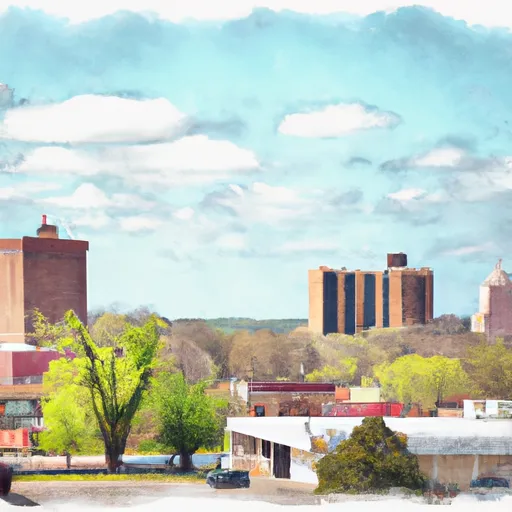-
 Snoflo Premium
Snoflo Premium
Get unlimited access to all our content
With no Ad interruptions! - Start Your Free Trial Login with existing account
Saratoga
Eden Index
Climate
7.7
•
Recreation
6.4
•
Community
•
Safeguard
5.3/10

Saratoga is a small town in southwest Arkansas, known for its beautiful natural surroundings and outdoor recreational opportunities. The town experiences a humid subtropical climate with hot, humid summers and mild winters. Summers are characterized by temperatures averaging in the upper 80s to low 90s Fahrenheit, while winters are relatively mild, with temperatures typically ranging from the 40s to 60s Fahrenheit.
Hydrologically, Saratoga is situated close to the Little Missouri River. This river is a popular spot for various water activities such as fishing, canoeing, and kayaking. The river is well-known for its scenic beauty and offers opportunities for both novice and experienced outdoor enthusiasts.
Saratoga and its surrounding areas offer numerous outdoor recreation opportunities. The nearby Ouachita National Forest provides ample opportunities for hiking, camping, and wildlife viewing. Additionally, the region has several lakes and streams, including Lake Greeson, which is famous for fishing and boating.
Overall, Saratoga, Arkansas, offers a pleasant climate, proximity to water bodies, and plenty of outdoor recreational activities, making it an ideal destination for nature lovers and outdoor enthusiasts alike.
What is the Eden Index?
The Snoflo Eden Index serves as a comprehensive rating system for regions, evaluating their desirability through a holistic assessment of climate health, outdoor recreation opportunities, and natural disaster risk, acknowledging the profound impact of these factors on livability and well-being.
Climate Health Indicator (CHI): 7.7
Saratoga receives approximately
1268mm of rain per year,
with humidity levels near 90%
and air temperatures averaging around
18°C.
Saratoga has a plant hardyness factor of
8, meaning
plants and agriculture in this region tend to thrive here all year round.
By considering the ideal temperature range, reliable water supplies, clean air, and stable seasonal rain or snowpacks, the Climate Health Indicator (CHI) underscores the significance of a healthy climate as the foundation for quality living.
A healthy climate is paramount for ensuring a high quality of life and livability in a region, fostering both physical well-being and environmental harmony. This can be characterized by ideal temperatures, reliable access to water supplies, clean air, and consistent seasonal rain or snowpacks.
Weather Forecast
Streamflow Conditions
Red-Little
Area Rivers
Red-Little
Snowpack Depths
Red-Little
Reservoir Storage Capacity
Red-Little
Groundwater Levels
Recreational Opportunity Index (ROI): 6.4
The Recreational Opportunity Index (ROI) recognizes the value of outdoor recreational options, such as parks, hiking trails, camping sites, and fishing spots, while acknowledging that climate plays a pivotal role in ensuring the comfort and consistency of these experiences.
Access to outdoor recreational opportunities, encompassing activities such as parks, hiking, camping, and fishing, is crucial for overall well-being, and the climate plays a pivotal role in enabling and enhancing these experiences, ensuring that individuals can engage in nature-based activities comfortably and consistently.
Camping Areas
| Campground | Campsites | Reservations | Toilets | Showers | Elevation |
|---|---|---|---|---|---|
| San Augustine - Sam Rayburn Reservoir | 100 | 194 ft | |||
| Ebenezer - Sam Rayburn Reservoir | 30 | 192 ft | |||
| Willow Oak | 15 | 216 ft | |||
| North Toledo Bend State Park | None | 258 ft | |||
| Red Hills Lake | 26 | 374 ft | |||
| Rayburn - Sam Rayburn Reservoir | 70 | 183 ft | |||
| Mill Creek - Sam Rayburn Reservoir | 110 | 181 ft | |||
| Twin Dikes - Sam Rayburn Reservior | 45 | 198 ft | |||
| Ragtown | 25 | 208 ft | |||
| Mission Dolores City RV Park | 32 | 345 ft |
Nearby Ski Areas
Catastrophe Safeguard Index (CSI):
The Catastrophe Safeguard Index (CSI) recognizes that natural disaster risk, encompassing floods, fires, hurricanes, and tornadoes, can drastically affect safety and the overall appeal of an area.
The level of natural disaster risk in a region significantly affects safety and the overall livability, with climate change amplifying these risks by potentially increasing the frequency and intensity of events like floods, fires, hurricanes, and tornadoes, thereby posing substantial challenges to community resilience and well-being.
Community Resilience Indicator (CRI):
The Community Resilience Indicator (CRI) recognizes that education, healthcare, and socioeconomics are crucial to the well-being of a region. The CRI acknowledges the profound impact of these elements on residents' overall quality of life. By evaluating educational resources, healthcare accessibility, and economic inclusivity, the index captures the essential aspects that contribute to a thriving community, fostering resident satisfaction, equity, and social cohesion.

